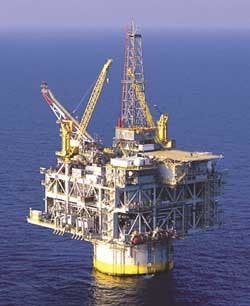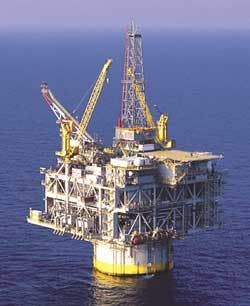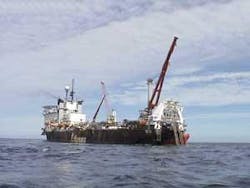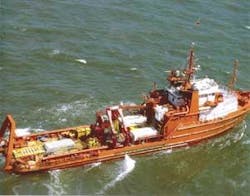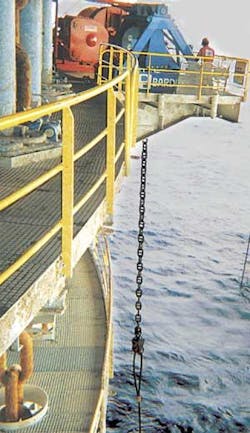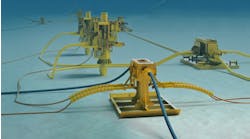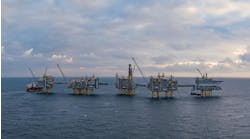Madison-Marshall hookup to Hoover Diana DDCV: The choreography of the SCR installation
The installation and tensioning of the steel catenary risers (SCRs) for the flowlines from the Madison and Marshall satellite fields to the ExxonMobil-operated Hoover Diana deep-draft caisson vessel (DDCV) in the western Gulf of Mexico represented a study in choreography. The planning, arrangement, and execution of the steps required for the hookups involved players from several companies closely coordinating and executing their individually assigned roles as part of a team effort. Allseas USA Inc. had overall responsibility for the execution of the work, including supervision of all subcontractors' work during the actual install-ation. Allseas also provided the Lorelay, a state-of-the-art 598.8-ft-long ship-shape pipelay vessel equipped with six welding stations and full dyn-amic positioning (DP) for maneuvering quickly in congested areas.
Cal Dive International provided the 198-ft DP Merlin vessel for the project's ROV and survey support. The Merlin features DP-1 capability and an 887-sq-ft clear work deck with marine handling equipment for deployment and recovery of the ROV. Cal Dive and its subsidiary, Canyon Offshore, provided ROV intervention services during the various rigging activities.
Bardex Corp.'s hydraulic actuated chain jack riser pull-in system, stored on the DDCV deck, was reactivated for the pull-in and tensioning of the 6 5/8-in. outside diameter (OD) SCRs during the Madison-Marshall hookup. The Bardex system was last used during initial installation and tensioning of risers connecting the surface production trees in the wellbay area on the DDCV to the wellheads at the seafloor when the Hoover and Diana fields were brought onstream.
The overall scenario for connecting the production from the Madison-Marshall developments to the DDCV called for the unique employment of a first-end SCR construction method, starting with the Madison SCR and followed by the Marshall SCR. The cut-off point between the first-end SCR installation procedure and the pipelay procedure was defined as just past the point where the transition between the last SCR joint and the first pipe-in-pipe (PIP) joint touches down on the seabed. Two 6-in. by 10-in. PIP flowline systems (one for Madison and one for Marshall) would run from the DDCV toward the satellite developments, a distance in each case of just under 6 mi. This would be followed by an uninsulated 6-in. infield flowline from Marshall to Madison. Four pipeline-end manifolds needed to be installed near the two subsea developments.
Preparations for safety and integrity
ExxonMobil-operated Hoover Diana DDCV in the Gulf of Mexico.
Allseas employed detailed stress analysis, computer simulations, and other engineering procedures in advance of the SCR installations to ensure the safety and integrity of all of the operations involved with the hookup of the two satellite fields.
These included loading the Bardex hydraulic riser pull-in system with chain, performing a functional test of the system's two chain jacks, and verifying their positioning above the hang-off seat mounted on the DDCV hull. Each of the two, 181-ton capacity chain jacks is pivot-mounted to a frame to allow rotation through an angle up to 15° from vertical along a plane through the center of the DDCV, and a 4° transverse angle simultaneously. Other components of the SCR pull-in system are a control panel on each chain jack and a dual, 40-hp hydraulic power unit.
Continuing with the platform preparations, the pull-in drum winch (for providing lateral pull-in force to guide the flexjoint in the hang-off seat) and pull-in wire guides were installed. The 1-in. rig pull-in wire also was installed through the subsea sheave block (in preparation for pulling the SCR into the seating assembly for the flexjoint). Using a subsea water blaster, the ROV removed debris that had accumulated on the hang-off seat and reeved a sling through the subsea sheaves. The hang-off seat is equipped with two receptacles (one for the Madison SCR, one for Marshall's) and is mounted to the hull of the DDCV at the Northwest corner at a water depth of 207 ft. Each receptacle is designed to carry the deadweight of its assigned riser. The subsea sheave block is mounted to the DDCV hull 7.8 ft above the receptacles. Merlin's ROV inspected the condition of the receptacles, riser clamps, and subsea sheaves.
Lorelay preparations
The SCR startup head flanges were bolted together and hydrotested. Each internal stiffener was screwed into its designated socket and pushed into the flexjoint, and the SCR startup head flange and flexjoint flange were made hydratight. The correct settings for the stinger, including stinger angle, were verified, as was the mounting and operability of the camera on one of the stinger's rollers. The loading of all SCR joints prior to start of SCR construction was verified, as was the sufficiency of supplies and consumables onboard.
The Allseas Lorelay pipelay vessel was used during Madison- Marshall hookup.
The SCR flexjoint was lined up in the weld beadstall, the firing line was filled with SCR joints, and the flexjoint was guided over the firing line rollers. Welding was stopped when the startup head reached the inner stinger. A transponder clamp was attached on the joint below the SCR flexpoint.
The proper performance of the surface navigation systems on the DDCV – a laser Fanbeam system and a digital global positioning system (DGPS) backup system – were verified and their interface with the Lorelay's DP system was tested. Being a DP vessel, the Lorelay's heading, roll, and pitch and the wind direction and speed can be measured as a means of controlling the alongship, athwartship and turning thrust force from each of the vessel's thrusters/propellers. The automatic positioning information provided by the Fanbeam system was to be used to maintain the Lorelay in a fixed position relative to the DDCV, i.e., in the event that the DDCV should change position, the Fanbeam system would automatically effect a corresponding change in the Lorelay's position. This would allow the Lorelay to operate in a "follow-platform mode," minimizing potential risk issues inevitably associated with working in close proximity to existing structures.
The "follow-platform mode" works to further decrease dynamic excursions of the pipeline during installation, which in turn would alleviate issues such as the structural integrity and fatigue life of the SCR. The Fanbeam system was to be used throughout the entire SCR installation, including hang-off and touchdown, so as to greatly reduce any anomalies resulting from the dynamic nature of the DDCV and/or Lorelay. Because the Fanbeam system is weather sensitive, the DGPS was installed as a backup system for relative positioning.
Loadline handover
With the completion of preparations and a favorable weather forecast for at least three days, the first step of the actual SCR construction began with the handing over of the loadline from the DDCV to the Lorelay. During this stage, the Lorelay pipelay vessel set up at a safe distance off the northwest corner of the DDCV in the "follow platform mode." The Merlin survey vessel picked up and transferred a messenger cable from the Lorelay to the DDCV. The crane on the DDCV transferred the loadline to the Merlin where the connection with the messenger cable was to be made. Subsequently, the connected wires were lowered from the Merlin's deck into the water in a controlled manner and released. The Merlin then moved out of the zone. Next, the Lorelay moved toward a stand-off distance and started taking in cable until the loadline connection had arrived at the inner stinger on the Lorelay. With the loadline recovered to the inner stinger, SCR pipe payout began. It should be noted that, during the preparatory work and the SCR installation, communication among the DDCV, the Lorelay, and the Merlin was via VHF radios.
Phase I SCR installation
Cal Dive International's Merlin vessel was used during Madison-Marshall hookup.
With the Lorelay remaining stationary and after some pipe joints had been paid out, the Bardex chain jack on the DDCV began hauling in chain attached to the loadline. As chain was hauled in, the tail end was positioned in a chain locker and stowed. Chain haul-in was measured by counting the number of links passing the chain jack. It should be noted at this point that the maximum chain jack angle for jacking was 15°, both relative to the vertical. Welding out pipe continued until some more joints had been dispensed, at which point phase II of the SCR installation began.
With the Lorelay moving forward, welding out of pipe continued, while the chain jack continued to haul in loadline. As was the case during phase I, the ROV continued to monitor the condition of the SCR's receptacle on the DDCV's hull. Phase II was completed when the chain jack had concluded hauling in the loadline, which occurred after the yellow mark arrived at the chain jack hinge, and was locked and idled, awaiting the hang-off phase of the SCR installation. At that point (completion of phase II), the Lorelay had laid several joints and the flexjoint had been raised approximately 6.6 ft above the receptacle.
Phase III SCR installation
In this phase of the operation, the Lorelay continued paying out pipe while moving forward, and the pull-in wire was connected to the flexjoint by the ROV. Next, the ROV installed a transponder in a transponder bracket located at the touchdown location on the seabed. After completion of the SCR section (169 joints), the SCR was inserted in the flowline transition joint, at which point welding of the PIP flowline was started. Phase III was completed when the pipeline sag was 100 m above the seabed.
Hang-off
This procedure called for the Lorelay to be stationary at a certain distance between the Lorelay's stinger and the chain jack hinge point. Pipe continued to be paid out until the sag of the pipe was above the seabed (with payout of almost 300 joints from the beadstall) at which point pipelay operation ceased until the pull-in was completed. With the ROV closely monitoring the receptacle on the hang-off seat located on the DDCV hull and relaying pictures to the Lorelay and DDCV, the flexjoint began to be pulled to the seat. Chain was then paid out to lower the flexjoint into the seat, at which point hang-off was achieved. At hang-off, approximately 11,000 ft of pipe had been paid out from Lorelay's beadstall.
With the flexjoint resting in the seat, pipe payout resumed until laydown on the seabed had been achieved. Using transponder input and close-up inspection, the ROV confirmed the touchdown and then moved to the hang-off seat to confirm the SCR hang-off angle.
Pipelay resumption
After touchdown, the Lorelay began to carefully pay out more pipe, while maintaining the SCR hang-off angle and touchdown point stable on the seabed. Such care was needed to minimize the bottom tension variations during pipelay until sufficient pipe had been laid out on the seabed to transfer a potential bottom tension differential. Once again, the ROV confirmed that the SCR was correctly hung off by reading the transponder in the bracket just below the flexjoint. Upon completion of this final SCR construction activity, over 300 joints had been paid out relative to the beadstall on the Lorelay.
With the SCR installation complete, the Lorelay proceeded in a normal pipelay mode, installing 15,886 ft of PIP flowline to finish the hookup to the Madison field.
The chain was re-rigged from the Madison chain jack on the DDCV to the Marshall chain jack, and the entire procedure described above was followed again to connect the Marshall field to the DDCV, starting with the preparation of the pull-in wire and loadline.
